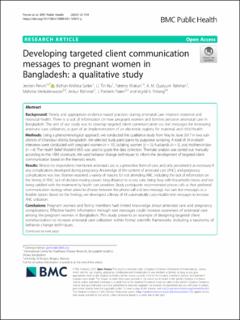| dc.contributor.author | Pervin, Jesmin | |
| dc.contributor.author | Sarker, Bidhan Krishna | |
| dc.contributor.author | Nu, U. Tin | |
| dc.contributor.author | Khatun, Fatema | |
| dc.contributor.author | Rahman, A. M. Quaiyum | |
| dc.contributor.author | Venkateswaran, Mahima | |
| dc.contributor.author | Rahman, Anisur | |
| dc.contributor.author | Frøen, Jahn Frederik Alexander Claude | |
| dc.contributor.author | Friberg, Ingrid Kristina | |
| dc.date.accessioned | 2021-09-10T07:19:43Z | |
| dc.date.available | 2021-09-10T07:19:43Z | |
| dc.date.created | 2021-07-20T12:34:04Z | |
| dc.date.issued | 2021 | |
| dc.identifier.citation | BMC Public Health. 2021, 21 (1), 1-13. | |
| dc.identifier.issn | 1471-2458 | |
| dc.identifier.uri | https://hdl.handle.net/11250/2775109 | |
| dc.description.abstract | AbstractBackground:Timely and appropriate evidence-based practices during antenatal care improve maternal andneonatal health. There is a lack of information on how pregnant women and families perceive antenatal care inBangladesh. The aim of our study was to develop targeted client communication via text messages for increasingantenatal care utilization, as part of an implementation of an electronic registry for maternal and child health.Methods:Using a phenomenological approach, we conducted this qualitative study from May to June 2017 in two sub-districts of Chandpur district, Bangladesh. We selected study participants by purposive sampling. A total of 24 in-depthinterviews were conductedwithpregnantwomen(n= 10), lactating women (n=5),husbands(n= 5), and mothers-in-law(n= 4). The Health Belief Model (HBM) was used to guide the datacollection. Thematic analysis was carried out manuallyaccording to the HBM constructs. We used behavior change techniques to inform the development of targeted clientcommunication based on the thematic results.Results:Almost no respondents mentioned antenatal care as a preventive form of care, and only perceived it as necessary ifany complications developed during pregnancy. Knowledge of the content of antenatal care (ANC) and pregnancycomplications was low. Women reported avariety of reasons for not attending ANC, including the lack of information onthe timing of ANC; lack of decision-making power; long-distance to access care; being busy with household chores, and notbeing satisfied with the treatment by health care providers. Study participants recommended phone calls as their preferredcommunication strategy when asked to choose between thephone call and text message, but saw text messages as afeasible option. Based on the findings, we developed a library of 43 automatically customizable text messages to increaseANC utilization.Conclusions:Pregnant women and family members had limited knowledge about antenatal care and pregnancycomplications. Effective health information through text messages could increase awareness of antenatal careamong the pregnant women in Bangladesh. This study presents an example of designing targeted clientcommunication to increase antenatal care utilization within formal scientific frameworks, including a taxonomy ofbehavior change techniques. | |
| dc.language.iso | eng | |
| dc.title | Developing targeted client communication messages to pregnant women in Bangladesh: a qualitative study | |
| dc.type | Peer reviewed | |
| dc.type | Journal article | |
| dc.description.version | publishedVersion | |
| dc.source.pagenumber | 1-13 | |
| dc.source.volume | 21 | |
| dc.source.journal | BMC Public Health | |
| dc.source.issue | 1 | |
| dc.identifier.doi | 10.1186/s12889-021-10811-y | |
| dc.identifier.cristin | 1922229 | |
| dc.relation.project | Norges forskningsråd: 248073 | |
| cristin.ispublished | true | |
| cristin.fulltext | original | |
| cristin.qualitycode | 1 | |
